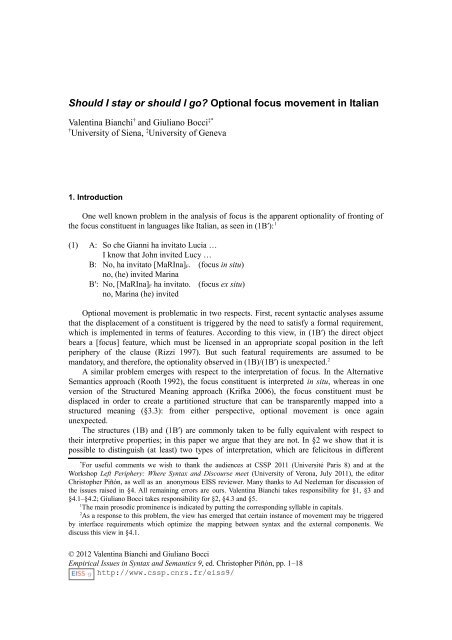Empirical Issues in Syntax and Semantics 9 (EISS 9 ... - CSSP - CNRS
Empirical Issues in Syntax and Semantics 9 (EISS 9 ... - CSSP - CNRS
Empirical Issues in Syntax and Semantics 9 (EISS 9 ... - CSSP - CNRS
You also want an ePaper? Increase the reach of your titles
YUMPU automatically turns print PDFs into web optimized ePapers that Google loves.
Should I stay or should I go? Optional focus movement <strong>in</strong> Italian<br />
Valent<strong>in</strong>a Bianchi † <strong>and</strong> Giuliano Bocci ‡*<br />
†<br />
University of Siena, ‡ University of Geneva<br />
1. Introduction<br />
One well known problem <strong>in</strong> the analysis of focus is the apparent optionality of front<strong>in</strong>g of<br />
the focus constituent <strong>in</strong> languages like Italian, as seen <strong>in</strong> (1B′): 1<br />
(1) A: So che Gianni ha <strong>in</strong>vitato Lucia …<br />
I know that John <strong>in</strong>vited Lucy …<br />
B: No, ha <strong>in</strong>vitato [MaRIna] F . (focus <strong>in</strong> situ)<br />
no, (he) <strong>in</strong>vited Mar<strong>in</strong>a<br />
B′: No, [MaRIna] F ha <strong>in</strong>vitato. (focus ex situ)<br />
no, Mar<strong>in</strong>a (he) <strong>in</strong>vited<br />
Optional movement is problematic <strong>in</strong> two respects. First, recent syntactic analyses assume<br />
that the displacement of a constituent is triggered by the need to satisfy a formal requirement,<br />
which is implemented <strong>in</strong> terms of features. Accord<strong>in</strong>g to this view, <strong>in</strong> (1B′) the direct object<br />
bears a [focus] feature, which must be licensed <strong>in</strong> an appropriate scopal position <strong>in</strong> the left<br />
periphery of the clause (Rizzi 1997). But such featural requirements are assumed to be<br />
m<strong>and</strong>atory, <strong>and</strong> therefore, the optionality observed <strong>in</strong> (1B)/(1B′) is unexpected. 2<br />
A similar problem emerges with respect to the <strong>in</strong>terpretation of focus. In the Alternative<br />
<strong>Semantics</strong> approach (Rooth 1992), the focus constituent is <strong>in</strong>terpreted <strong>in</strong> situ, whereas <strong>in</strong> one<br />
version of the Structured Mean<strong>in</strong>g approach (Krifka 2006), the focus constituent must be<br />
displaced <strong>in</strong> order to create a partitioned structure that can be transparently mapped <strong>in</strong>to a<br />
structured mean<strong>in</strong>g (§3.3): from either perspective, optional movement is once aga<strong>in</strong><br />
unexpected.<br />
The structures (1B) <strong>and</strong> (1B′) are commonly taken to be fully equivalent with respect to<br />
their <strong>in</strong>terpretive properties; <strong>in</strong> this paper we argue that they are not. In §2 we show that it is<br />
possible to dist<strong>in</strong>guish (at least) two types of <strong>in</strong>terpretation, which are felicitous <strong>in</strong> different<br />
*<br />
For useful comments we wish to thank the audiences at <strong>CSSP</strong> 2011 (Université Paris 8) <strong>and</strong> at the<br />
Workshop Left Periphery: Where <strong>Syntax</strong> <strong>and</strong> Discourse meet (University of Verona, July 2011), the editor<br />
Christopher Piñón, as well as an anonymous <strong>EISS</strong> reviewer. Many thanks to Ad Neeleman for discussion of<br />
the issues raised <strong>in</strong> §4. All rema<strong>in</strong><strong>in</strong>g errors are ours. Valent<strong>in</strong>a Bianchi takes responsibility for §1, §3 <strong>and</strong><br />
§4.1–§4.2; Giuliano Bocci takes responsibility for §2, §4.3 <strong>and</strong> §5.<br />
1<br />
The ma<strong>in</strong> prosodic prom<strong>in</strong>ence is <strong>in</strong>dicated by putt<strong>in</strong>g the correspond<strong>in</strong>g syllable <strong>in</strong> capitals.<br />
2<br />
As a response to this problem, the view has emerged that certa<strong>in</strong> <strong>in</strong>stance of movement may be triggered<br />
by <strong>in</strong>terface requirements which optimize the mapp<strong>in</strong>g between syntax <strong>and</strong> the external components. We<br />
discuss this view <strong>in</strong> §4.1.<br />
© 2012 Valent<strong>in</strong>a Bianchi <strong>and</strong> Giuliano Bocci<br />
<strong>Empirical</strong> <strong>Issues</strong> <strong>in</strong> <strong>Syntax</strong> <strong>and</strong> <strong>Semantics</strong> 9, ed. Christopher Piñón, pp. 1–18<br />
http://www.cssp.cnrs.fr/eiss9/











